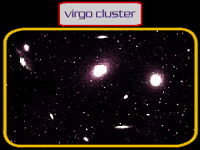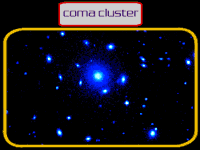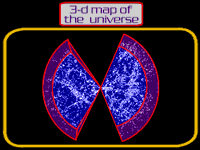- Objective:
To learn about the large scale structure of the universe.
- New Concepts:
-
cluster, supercluster
|
-
Even though the galaxy we call home is 100,000 light years across, the vast expanse of space continues far beyond our Milky Way. The observable universe is actually an assembly of up to 100 billion galaxies, some of which are much larger than than our own. Yet no matter how enormous they are, galaxies do not float freely through the universe. Instead, each galaxy is just a single part of a larger union of galaxies called clusters and superclusters.
|

Fig.1 The Virgo Cluster (central zone). It is some 60 million light years away and stretches about
10 million light years. The Virgo Cluster is a rich but irregular cluster with more than 1,000 galaxies.
The two brightest object in the center and center right are elliptic galaxies. If you were to travel from one of
them to the other at the speed of light, it would take two million years to finish the journey.
|
- Galaxy Cluster
-
Like stars, the galaxies also tend to clump together to form a larger structure. These structures, referred to
as galaxy clusters or simply, "clusters," are typically tens of million
of light years across. Under the influence of gravity, the galaxies in a cluster slowly revolve around one
another much like planets orbit the Sun.
Our Milky Way is part of the cluster called the Local Group. It is a small cluster, containing only dozens
of galaxies. A large cluster -- such as the Virgo cluster shown in Figure 1 -- can collect thousands of
galaxies. The large cluster is also classified as a "rich cluster."
|

Fig.2 The Coma Cluster. It has a ball-shape and is about 300 million light years away. The Coma
Cluster is a rich, regular cluster that contains many thousands of galaxies. Almost every object in the
photograph is a galaxy -- and many of these galaxies contain as many stars as our own Milky Way.
|
- Supercluster
-
Clusters of galaxies are further grouped into long, stringlike structures known as superclusters. The supercluster typically has a dimension of
hundreds of millions of light years and contains tens of thousands of galaxies. The supercluster we are in
is called the Local Supercluster or the Virgo Supercluster. It contains about 50,000 galaxies and stretches
at least 120 million light years across. Surrounding our supercluster is an immense void -- a huge region
where few galaxies have been found. This void is so gigantic -- measuring some 300 million light years
across -- that our huge Local Supercluster is dwarfed.
|

Fig.3 The galaxy survey made by the Harvard Smithsonian Center for Astrophysics. This is a "3-dimensional" survey that plots the coordinates of the galaxies on the sky as well as their distance from us. Two regions of the sky are shown here with about 500 million light years in depth. Each dot represents a galaxy brighter than a chosen brightness, and our position is at the center. The nearly horizontal bunch of galaxies stretching across the top region has been called the "Great Wall" -- the
largest structure humans have ever observed. The voids can also be easily seen in the figure. Click the
figure for an enlarged view. Be careful: the foreground and background galaxies can hardly be
distinguished in this figure.
Figure Credits:
The Electronic Universe Project
Fig.2 UK Schmidt Telescope; Royal Observatory Edinburgh,
Anglo-Australian Observatory, and AURA©
Fig.3 Harvard Smithsonian Center for Astrophysics
|
-
To map how galaxies are distributed, astronomers have been working to create a three-dimensional
survey of the universe. To keep track of the galaxies, astronomers have sectioned off the sky into
fan-shaped slices. They examine each slice to look for galaxies that are above a certain brightness level
and then they record those galaxies on their maps.
Although most slices have not yet been surveyed, the finished slices have already brought us a surprise.
The universe still does not appear to be uniform (see Fig.3) -- even though astronomers have surveyed a
huge area of 500 million light years, which amounts to one thirtieth of the whole observable universe.
Instead of appearing uniform and regular throughout, the universe looks more like a sponge: the galaxies
are arranged in interconnected lines and sheets, and they enclose large bubbles in which very few
galaxies can be seen.
What does the universe look like on scale beyond hundreds of millions of light years? Is there any larger
structure? We do not yet know the answer to these questions. However, we do know that onthe largest observable scale -- some 15 billion light
years in diameter, our universe appears to be extremely homogenous. We will discuss this in more detail
later in the Galaxy Formation unit.
|

